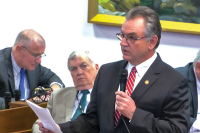Dayco deal finalized after three-year process
An abandoned rubber plant in Waynesville that once seemed destined to rust into the ground was officially turned over to developers of a Super Wal-Mart and Home Depot two weeks ago.
The deal has been in the making for three years. It was expected to close months ago, but was held up by a string of obstacles. For starters, the old Dayco rubber factory was home to underground contaminants that the new owners wanted no part of and had to be cleaned up by the former owners. Developers had to navigate the town’s pedestrian-friendly building codes. The state made them develop a new design for the roads around the site to accommodate the extra 10,000 cars expected to flood the area on busy Saturdays. They had to lobby for railroad crossings and trout stream buffer permits. Finally came the mention the massive demolition of the old plant.
The developers are paying $2.1 million for the 35-acre site, which straddles South Main Street and exit 98 off the bypass. The money will go to the town of Waynesville and the county — which fronted the money to buy the old plant five years ago — and to the Haywood Advancement Foundation, a non-profit economic development arm that’s played a key role in bringing the deal to fruition.
The deal was made possible by swift and visionary action of economic development leaders five years ago, and by a healthy dose of good luck, according to Gavin Brown, a Waynesville town alderman and member of the county economic development commission.
First a bust, then a boon
When the rubber plant closed in 1998, leaving 800 out of work, the prospects of finding a taker for the site didn’t seem good. A group of businessmen soon rolled into town and bought the property making lofty promises to open a tankless hot water heater plant, and later an upscale outlet mall. They never delivered, and instead landed in and out of bankruptcy court.
Tired of the property being held hostage, Haywood Advancement Foundation hatched a plan to wrest the property away from the businessmen. Borrowing $650,00 from both the town and county, the non-profit economic development arm plopped down $1.3 million to buy the property out of bankruptcy.
“They said we have to get this property out of these gentlemen’s hands, out of the hands of the bankruptcy court and let the community take care of itself,” Brown recalled.
Haywood Advancement, along with the county economic development commission, set about the tough task of marketing the rusting factory site with environmental containants.
“They made strenuous efforts to get industry to look at it but it just wasn’t going to happen,” said Brown, also a member of the Haywood Advancement Foundation. “It was concluded that commercial was probably a better way of developinog the property.”
A bit of luck
Here’s where the luck came in, said Brown, an attorney. One of Brown’s clients, a second-home owner in Waynesville, worked as a property scout for commercial developers.
“They find the sites and try to sell the site to the developer, almost like a broker,” Brown said. “The developers don’t have the time to go find the properties.”
One day, Brown pitched the old Dayco plant to the property scout. When he drove her past it, a light bulb went off. She knew of a national commercial developer that had experience turning abandon factory sites into retail shopping. That was three years ago.
While the county and town will both get the $650,000 back they put up for the property, the real financial boon belongs to Haywood Advancement Foundation. While the upfront money to buy the property out of bankruptcy court came from the county and town, the non-profit was technically the title holder of the property and are claiming the leftover proceeds, which Brown pegs at roughly $500,000 after expenses.
The group’s plan is to pump the money back into economic development, but with a new approach, said Brown. Just 10 years ago, economic development primarily centered on buying tracts of land, leveling out a building pad and offering it at a discount to manufacturers willing to set up shop here. But Brown said the group is interested in a creative model for economic development that focuses on supporting entrepreneurs
“If people come to us with an idea, we could act as a funding agency,” Brown said. It would go a long way to address the top complaint of aspiring companies: the lack of capital to get started.
“It’s going to be hard. You will be surprised at who is going to come knocking at your door,” Brown said of the task ahead.





